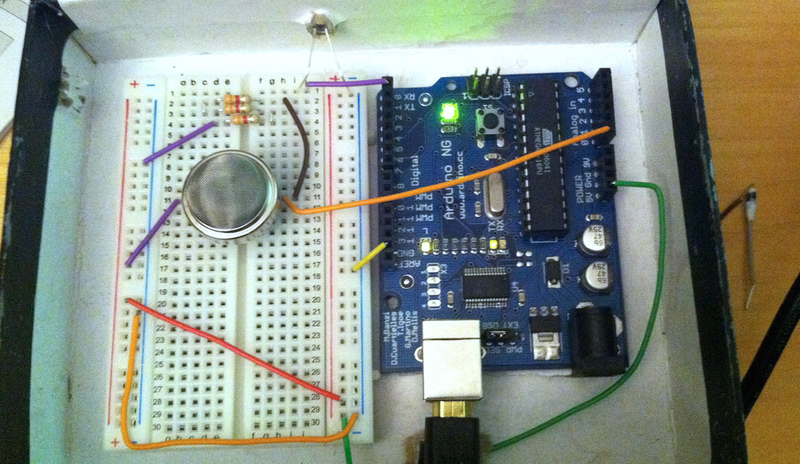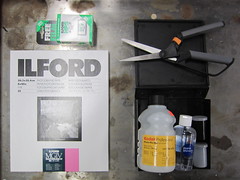
Hydrogen Sulfide Sensing
Purpose
Hydrogen sulfide, which is a well documented but little understood health hazard, is one of the leading causes of injury in the workplace. Health issues have been clearly linked to H2S, and since 2011 the EPA has required the oil and gas to report their emissions to the Toxics Release Inventory (TRI). Despite this much hydrogen sulfide still gets into the air with little regulation (Fracking Boom Spews Toxic Air Emissions on Texas Residents). Public Lab researchers are attempting to innovate novel, low-cost community based approaches to environmental health problems like hydrogen sulfide, so that communities and workers may begin not only developing systems to track their exposure, but also generating data and evidence in order to scientifically validate their experiences.
The photopaper sensing tool is being developed to detect hydrogen sulfide in an affordable, quantifiable manner. In September of 2011, Public Laboratory members met with residents of Garfield County, Colorado to discuss the growing hydrogen sulfide problem in their small, rural community. The community had recently organized to take a gaseous grab sample from one resident’s kitchen sink. Analysis of the grab sample showed hydrogen sulfide levels of more than 185 times above the long-term exposure level recommended by the EPA (Gassed by Global Community Monitoring). The family, in which the son developed painful skin lesions and other symptoms coincident with this exposure, was forced to abandon the house. They are seeking legal assistance, but so far, neighboring gas development companies have denied association with the families water contamination. The grab sample, while able to capture one record of exposure, was costly (over $500) and had to be shipped to a lab in California within 24 hours in order to ensure the samples viability. The family did not hear results of the test for weeks, all the while continuing their exposure.
Basic Information on Hydrogen Sulfide
Hydrogen Sulfide Monitoring in Gas Patch: Background
Hydrogen Sulfide: Information on the Gas
Conversion from µg/m3 to ppm hydrogen sulfide
Development History
We currently have two approaches to sensing hydrogen sulfide in development.
First Prototype: Digital Sensor
Our first prototype used a digital sensor for hydrogen sulfide. Advantages of this system is that data from the sensor could be logged over time and that tool is reusable and portable. However the Figaro TGS 825 sensor itself is relatively expensive--approximately $60 for an individual sensor and $40 in bulk.
Arduino and Industrial H2S Sensor
More information on the digital sensor:
Temperature and Humidity Sensors to Correct H2S
Arduino + Figaro Hydrogen Sulfide Sensor
Arduino Patch for Detecting Hydrogen Sulfide
Hydrogen Sulfide Detection for Fart Detector
Second Prototype: Photographic Paper
Our second prototype uses photographic paper to detect hydrogen sulfide. The silver halide in photographic paper tarnishes when exposed to H2S. The paper changes color inside the canisters depending on the level of H2S it has been exposed to, with darker strips indicating higher levels of exposure. This method is low-cost, easy to assemble using everyday materials, and may be more accessible to non-programmers.
Photographic Paper for H2S Sensing
More information on the photographic paper:
Hydrogen Sulfide Testing with Black and White Film
Hydrogen Sulfide Tarnishing Silver
Controlled Testing with B&W Film Hydrogen Sulfide Detectors
Protocol
This project is based on these two papers by geologist C. J. Horwell and colleagues that used photographic paper to measure hydrogen sulfide concentrations near volcanos in New Zealand.
Horwell, C.J., Allen, A.G., Mather, T.A., Patterson, J.E., 2004. Evaluation of a simple passive sampling technique for monitoring volcanogenic hydrogen sulphide. J. Environ. Monitor. 6, 630 - 635. Horwell_JEM_2004_copy.pdf
Horwell, C.J., Patterson, J.E., Gamble, J.A., Allen, A.G., 2005. Monitoring and mapping of hydrogen sulphide emissions across an active geothermal field: Rotorua, New Zealand. J. Volcanol. Geotherm. Res. 139, 259-269. Horwell_JVGR_2005_copy.pdf
Original photopaper map made by Horwell et al.
Field Test Sites
Aztec, New Mexico
Map of area to be tested in Aztec, NM
Choosing Test Sites in Aztec, NM
Identifying Wells in Field and Experiment Design
Collection and Processing of Aztec Test Strips
Analyzed Results and Suggested New Steps for H2S Testing in Aztec, New Mexico
New Experimental Design, Aztec, New Mexico
New Container Tests, Aztec, New Mexico
Designs for Next Round of Experiments, Aztec, New Mexico
Powder River Basin, Wyoming
Results of three rounds of testing in Deaver, WY
Photopaper Sensing Tool - Development Notes, Deaver, WY
Wyoming Hydrogen Sulfide Testing 2013-2014
How to make your own
Canisters in the process of being set up
Below are resources for making your own H2S test kit!
How to Guide:
Short-term goals:
- to successfully sense hydrogen sulfide with photographic paper

- to develop step by step guides to making the tools

- to standardize the photopaper test within laboratory conditions in Louisiana
- to develop open source tools for analyzing the photopaper
- to design a public lab kit
Start Contributing and Get involved!
If you are interested in helping develop hydrogen sulfide sensing, please contribute thoughts, comments and research notes on this page as well as join us on the Public Lab mailing list.
Currently active work on the film assay is being done at Northeastern University by Sara Wylie, Elisabeth Wilder, Deb Thomas, Cait Kennedy, Megan McLaughlin, and Hannah Gartner.
Feel free to contact any of the people listed above if you are interested in getting more involved. You can also try following the prototype documentation to make your own film testing strips, and be sure to share any new tests sites or uses for this tool.
This project is partially funded by a grant from the American Anthropology Association, Anthropology and Environment section





